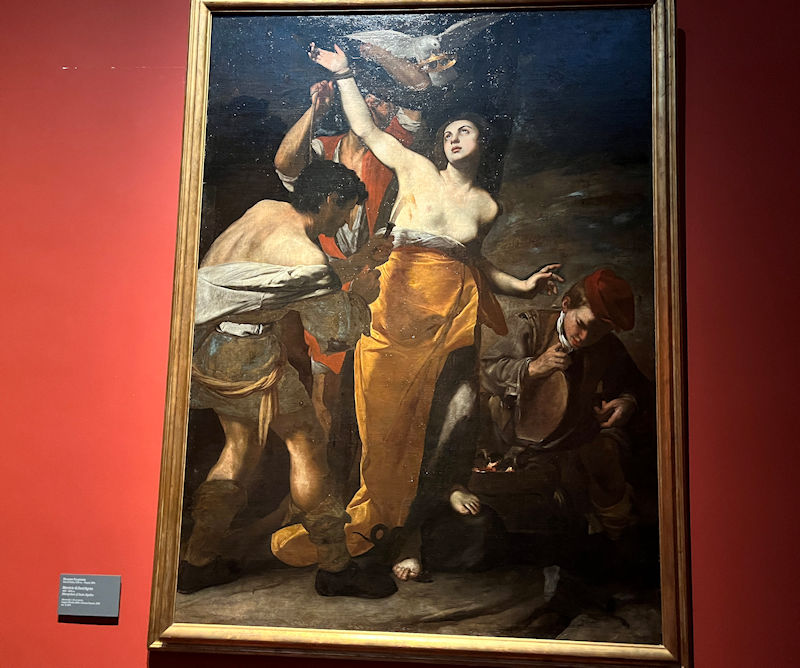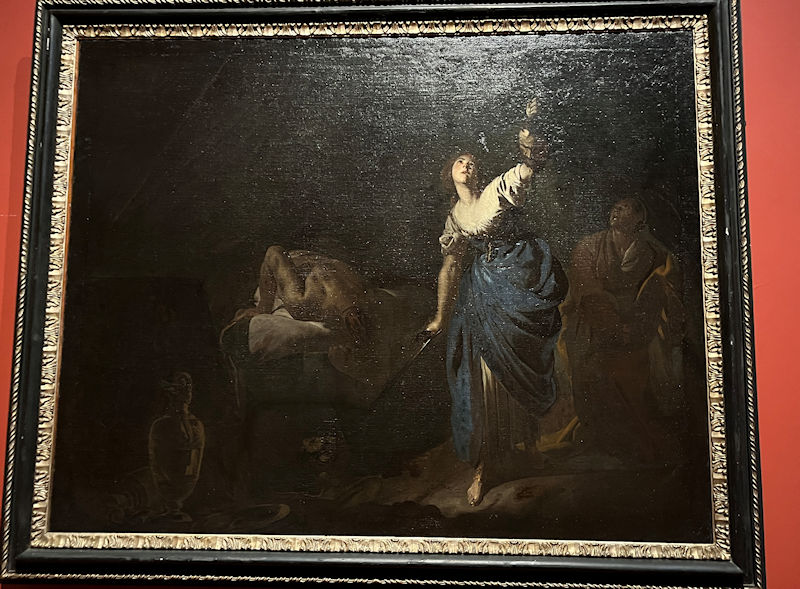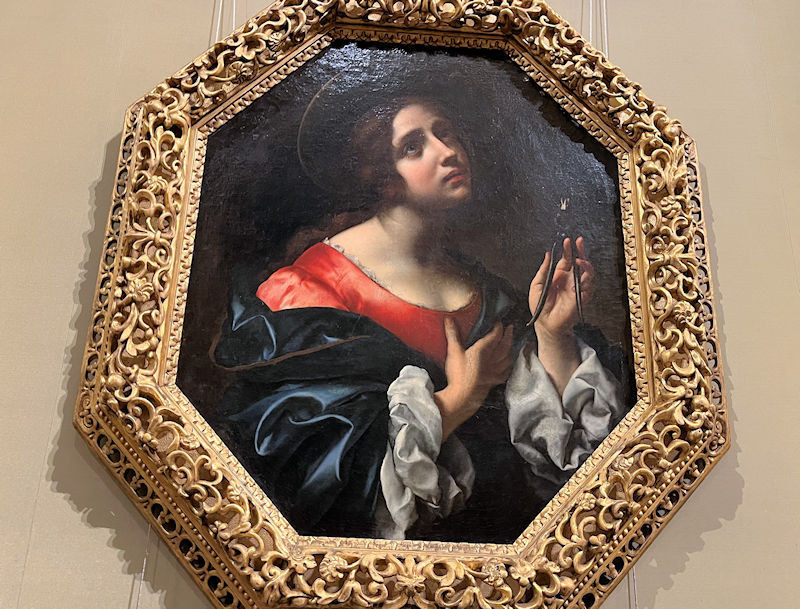You may not find this terribly rewarding unless you're included here, so this is a good time for casual and random browsers to turn back before they get too caught up in the sweep and majesty of the proceedings and can't let go.
There is a certain something about Christian art. To start us off, this is the Martyrdom of St. Christina, by the "Pseudo-Jacopino", 1329, in the Pinacoteca Nazionale in Bologna [viewed in 2014]
Saint Agatha (Sant'Agata)
Poor St Agatha of Sicily is said to have been martyred in Catania in the Decian persecutions of 251. Amongst the many grim prison tortures that failed to shake her resolve, her breasts were removed with pincers, and thus her iconographic tradition. She was one of the earliest and most widely venerated of the martyr saints.

Poor St Agatha (patron of breast cancer patients)-- this is by Giovanni di Pietro of Pisa, ca. 1420, in the Pinacoteca Malaspina in Pavia.

The cult of St Agatha over the centuries, with her iconographic breasts on a plate, and her martyr's palm; Ortensio Crespi, 1616, also in the Pinacoteca Malaspina, Pavia.

Oh, poor St Agatha (perhaps by Giacomo Paravicini, called 'il Gianolo', early 18th century). Also in the Pinacoteca Malaspina. As with many other martyr-saints, her most elaborate story is found in Jacobus de Voragine's 13th century Golden Legend (of which selections, translated by Christopher Stace were published by Penguin in 1998). There we learn that she was a 15-year-old noble Christian girl in Sicily who'd made a vow of virginity, and was turned in to the authorities by a frustrated suitor during the persecutions of Decius (250-253).

Poor Saint Agatha was a perennial hagiographical favorite, "the patron saint of breast cancer patients, martyrs, wet nurses, bell-founders, bakers, fire, earthquakes, and eruptions of Mount Etna". This is from about 1630 by 'Anonymous' in the Musée Fabre in Montpellier.

This is Zubarán's version, about 1635, in the Musée Fabre. Still following the Golden Legend, despite confinement in a brothel and horrific tortures in prison, Agatha remained steadfast; she was meant to be burnt at the stake but an earthquake intervened and she was sent back to prison, where the Apostle Peter appeared and healed her wounds. Nonetheless, she is said to have died in prison in about 251, steadfast to the end.

Saint Agatha looks merely puzzled about why she's holding her iconographic breasts on a plate. The fellow on the left is St Liberator (or Eleutherius), the young Bishop of Messina (or Illyricum), who with his mother was clubbed to death on the orders of Emperor Hadrian. (Altarpiece of Sant'Agata, by Lello da Velletri, ca. 1427, in the National Gallery of Umbria, in Perugia) [seen 2015]

Poor young Agatha, with her martyr's palm and a plate with her iconographical credentials on it (Francesco di Simone da Santacroce, late 15th century). In the Museo Civico in the Church of the Eremitani in Padua.

The Order of Santa Chiara (the 'Poor Clares') was founded in 1212 by Clare of Assisi, an early devoted follower of St Francis and his new Franciscan order of mendicant itinerant preaching brothers, with more than 20,000 Poor Clare nuns in the world today. The nuns had a monastery in San Marino from 1609 to 1971 and when it closed, its contents were inherited by the Museo di Stato in San Marino.

With St Marinus, St Agatha is actually a co-patron saint of San Marino, and her tribulations, and those of some other female martyrs, must have been a natural for contemplation by the Poor Clare nuns of San Marino. This is by an unknown 17th century artist -- the San Marino museum is a treasure trove of St Agatha pictures.

A few more from the nuns' collection . . .

A fascination with St Agatha and her inspired composure

Still from the nuns' collection

This Saint Agatha is being ministered to by St Peter and an angel, by Giovanni Lanfranco, from the Carlo Bononi exhibition in the Palazzo dei Diamanti in Ferrara, 2017.

Here is our famous Agatha of Sicily, Catania specifically, martyred in the Decian Persecution of 251 and presently the patron saint of breast cancer patients, wet nurses, and earthquakes. This was paired with a full-length St Lucia (just below), two pieces that probably once flanked a central picture, presumably the Virgin and Child. In the Art Institute of Chicago [2021]

'St Peter healing St Agatha', ca.1614, by Giovanni Lanfranco. We first saw this Lanfranco picture amongst a Carlo Bononi exhibition in the Palazzo dei Diamanti in Ferrara in 2017. Oddly, though, the Web Gallery of Art cites this picture as being in the Galleria Nazionale in the Pilotta in Parma, Lanfranco's birthplace; perhaps one or the other is a copy. Seen here in the Galleria Corsini, Rome, October 2024

The grim 'Martyrdom of St Agatha' with that half-shirted mastectomist setting about his work (credited to Massimo Stanzione of Naples, dated to 1618-1620). Museo di Capodimonte, October 2024.

It's okay, though, because St Peter visited Agatha in prison and cured her ailings at that time (though she was martyred anyway). This is attributed to the Neapolitan Antonio de Bellis, active in Naples 1630-1660.

Great, another Judith and Holofernes, this by Bernardo Cavallino (Naples 1616-c.1656), dated to c.1645. Capodimonte, 2024.
Saint Lucy (Santa Lucia)
Saint Lucy (Santa Lucia) was a very early martyr-saint, widely venerated from early on, who was said to have been denounced as a Christian by another frustrated suitor and, when she refused to sacrifice in the Emperor's cult, was executed in Syracuse in 304 during the persecutions of Diocletian.
By the 15th century, a gruesome detail had accrued to her story, that prior to her execution her eyes were gouged out (or that she gouged her own eyes out to become less desirable to suitors), and thus she is frequently shown (with her eyes intact) carrying round her eyes on a plate.

Santa Lucia, shown here with St Ansanus ("the Apostle of Siena"), preacher of the Gospel around Bagnoregio, and St Bernardino of Siena; by an anonymous Viterbese in the 15th century, in the Civic Museum of Viterbo. Lucia is thus the patron saint of the blind, glass workers, and salesmen, for some reason, and is iconographically shown with her eyes on the plate, a lamp, a dagger, and sometimes two oxen, for some reason.

Madonna and Child and some more martyred saints with their own iconographic identifiers -- Lucia (eyes on a plate) and Catherine of Alexandria (spikey wheel, and martyr's palm) (attributed to Boccaccio Boccaccino, early 16th century), in the Civic Museum in the Eremitani in Padua.

St Lucia, former eyes prominently displayed, in the Pieve Santa Maria church in Arezzo [2015]

A coquettish Lucia, by Giovan Battista Lucini of Crema, ca. 1670. Lucy was normally shown holding her eyes, symbols of her tortures and martyrdom, either like this or in a cup or on a plate, but also with an apparently functional pair of eyes in her head as well. In the Museo Civico Cremasco in Crema [2018].

This calm Lucia is Spanish and dated to about 1500, and made with both oil and gold. In the Art Institute of Chicago, USA [2021]

This is a rather odd tableau by Giuseppe Cades, dated to 1781, purporting to show 'St Peter appearing to St Lucia and St Agatha'. 'Appearing to' doesn't really seem to explain what he's up to here. The saintly ladies are seen with the dinner plates bearing their iconographic symbols. The Pinacoteca di Ascoli Piceno, viewed in 2022.

In the Chiesa di San Ferdinando in Naples, viewed in October 2023
Saint Apollonia

Like all of the Old Martyrs, Saint Apollonia would like to remind us of her sorry fate -- getting all her teeth pulled out, for some reason, in 3rd century Alexandria. (There are two sides to every story.) In some paintings, that tooth she's holding is glowing supernaturally. She's known as the patron saint of dentistry (intended as a joke?), and in medieval times millions of her teeth were sold as a toothache cure. (ca. 1488, by the Master called Ambrogio the Saracen, in the Pinacoteca Nazionale in Bologna) [viewed in 2014]

Amongst pitiable female martyrs, after St Agatha, poor St Apollonia is right up there, with her iconic pliers wrongly suggesting that she pulled her own teeth out (by Carlo Francesco Nuvolone from Milan, 17th century, in the Castello Visconteo in Pavia).

Oh no, not the pincers! Poor Saint Apollonia, looking quite untroubled here, martyred in the persecutions in Alexandria in about 240 (for refusing to give up either virginity or Christianity, you choose). As to the traditional pincers -- she became the patron saint of dentistry, 'nuff said. (By Giovanni Battista Salvi, about 1650, in the Musée Fabre in Montpellier, France)

A stunned St Catherine with her wheel and an affectless St Apollonia, holding one of her own teeth in the pincers; by Gaudenzio Ferrari, ca. 1471-1546, born in Vercelli and working in the Piemonte, a prolific contemporary of Defendente Ferrari but not related to him. In the Palazzo Madama in Torino, 2019.

'St Apollonia', by Carlo Dolci of Florence (1616-1686). She's always shown holding her tooth in a pair of pliers, though no one's ever suggested that she pulled her own teeth out. She's known as the patron saint of dentistry (intended as a joke?), and in medieval times millions of her teeth were sold as a toothache cure. In the Galleria Corsini, Rome, October 2024.
Saint Rocco (or Roch)
St Roch or Rocco is said to have been a noble lad from Marseilles in the 14th century who came to northern Italy as a mendicant pilgrim and devoted himself to ministering to victims of the plague -- effecting many miraculous cures, we're told. When Rocco came down with the illness himself, he was expelled from Piacenza to avoid contagion and went off into the wilderness alone; there he would have died but for a dog that brought him bread and healed his wounds by licking them. He was associated with the plague in many places, but during the plague years 1477-1479 his cult spread rapidly throughout northern Italy.

In the Cattedrale di Santa Maria Assunta, or Duomo di Cremona, this is the altar (built in 1630) of Saint Rocco, or Roch, the 14th century son of the governor of Montpellier in the Languedoc who gave away his riches and came to Italy to cure people of the plague by making the sign of the cross over them, and who is usually shown revealing the plague sores that he inevitably contracted for himself. And with the little dog who brought him bread during his retreat into the wilderness.

Saints Sebastian and Roch, always together in museums for eternity. Sebastian's taken a nasty one in the forehead in this version, and St Roch or Rocco, the plague fighter (d.1327), is showing off his bubo again (Bernardo Parenzano, ca.1490). In the Museo Nazionale di Villa Guinigi in Lucca [2014]

Madonna and Son, with St Sebastian and Rocco with the buboes (Zacchia da Vezzano, ca. 1530, likewise in the Villa Guinigi, Lucca) [2014]

Terra cotta Madonna and baby with St Francis and St Rocco (showing off his buboes on the right), by Agnolo di Polo, a disciple of Verrocchio, late 15th century, in the the Chiesa della Santissima Annunziata on the Via Garibaldi, Arezzo [2015]

Madonna and Child, with Saints Rocco, Ubaldo, Dominic, and Sebastian, attributed to Orlando Merlini, late 15th century. Rocco is a little unusual here; he was a 'plague saint' normally shown displaying his bubo on his leg, to show that he was not afraid, and being sustained by a dog bringing him a loaf of bread. Here, no bubo, just Rocco waving a biscuit, and what is apparently meant to look like a dog but doesn't. In the Palace of the Consuls in Gubbio, November 2015

-- Hey, buddy, want to see a bubo? In the Santa Maria Maggiore church in Sirmione on Lago di Garda,
May 2016

Saint Rocco, the buboes man (Domenico Morone, early 16th century), in the Museo Civico di Castelvecchio in Verona, May 2016

St Michael with his lance and St Rocco with his buboes, among the faded 12th to 16th century frescoes in the ancient Lombard church of St Peter in Mavino, built in 765 and renovated in the early 1300s, out a ways on the peninsula of Sirmione. [viewed in 2016]

Saint Rocco in full kit, with his signature plague buboes and dog bringing him bread, by il Moncalvo in 1608, now in the Museo Civico in the cloister of the former Augustinian convent of Santa Croce in Casale Monferrato. (May 2016)

St Rocco on the right, patron saint of victims of the plague (always contentedly calling attention to the buboes on his leg), dogs, and bachelors; by Sebastiano Florigerio, mid-16th century. Rocco, or St Roch, is often paired with St Sebastian (him of the arrows, which actually he survived, but was later clubbed to death), who was also a patron saint of the plague-stricken (and of archers). In the Museo Civico in the Eremitani, Padua, March 2017

The Chiesa di San Rocco in the Piazza dei Martiri in Belluno, the Veneto, was commissioned in 1530 in thanks for deliverance from the plague, and completed in 1562. This is one of the two anonymous 16th century frescoes on the façade under the portico. Rocco, or St Roch, experienced a burst of veneration in the late 15th and 16th century for his association with plague-healing and is always shown pointing to buboes on his leg ('See? I've got one, too, and I'm feeling fine.'). He's nearly always shown paired with Sebastian, him of the arrows. March 2017

A statue of St Rocco in the middle, paintings of St Sebastian on the right, and a guy called St Saba on the left (Sabbas 'the Sanctified' was evidently a 6th century founder of monasteries in the Near East whose remains were brought to Italy by Crusaders in the 1100s and only returned in 1965.) In the Dominican Church of San Nicolò in Treviso [viewed 2017]

A St Roch (It. San Rocco, here São Roque) with a difference -- normally this saint, patron of plague victims, especially popular in northern Italy, is shown pointing to a plague bubo on his leg; here he's got a little kid to do it for him (German, first half of the 16th century). In the Museu Nacional de Arte Antiga, Lisbon [2017]

St Rocco in a crowd. This is an altarpiece of St Vincent Ferrer, a late 14th century Spanish Dominican said to have been a specialist at converting Jews to Christianity 'by a variety of means', paired with the inseparable lads St Sebastian and St Rocco showing off his plague buboes on his leg again. By Ghirlandaio and his workshop, about 1494. In the Museo della Città in Rimini. (December 2017)

A fresco in the crypt of the Basilica Cattedrale della Vergine Assunta, the Duomo of Lodi in Lombardy. The cult of the 14th century St Rocco was super-trending through northern Italy around the time of the plague years of the late 15th century. (February 2018)

This, in the Chiesa di San Rocco in Lodi, Lombardy, is Saint Rocco himself, patron of plague patients always shown displaying his bubo and accompanied by a faithful dog with bread for Rocco in its mouth. It was not uncommon for Italian cities to have chapels or churches dedicated to San Rocco near the gates to the city, to prevent the plague from entering, and this new church is located on the site of just such an old chapel.

St Rocco and his faithful dog are everywhere! This is the Church of San Lorenzo, or St Lawrence, in Lodi, on Garibaldi Street. (February 2018)

-- Is that another San Rocco? Who else would be showing off his buboes? (In the same San Lorenzo church in Lodi)

St Sebastian with more arrows than should have been necessary, and St Rocco showing of his buboes from the plague; from the mid-15th century onward, they are very frequently shown together. That's called the 'Virgin of Grace' in the centre. This is in the Chiesa del SS. Corpo di Cristo, built between 1437 and 1444 and frescoed by Masolino da Panticale, in the tiny medieval village of Castiglione Olona, adjacent to Venegogo just west of Como. (February 2018)

Just inside the front door of the Basilica di San Fedele, dedicated to Saint Fidelis of Como, in downtown Como, this is a rather conventional triptych of the enthroned Madonna with child, flanked by Sebastian with his arrows and Rocco with his plague buboes, attributed to Giovanni Andrea de Magistris, early 16th century.

-- 'See? I've got one, too, and I'm feeling fine.'
In the Chiesa dell'Addolorata, Offida, Marche, Italy, viewed in 2022.

Rocco on the right, with bubo, next to Sebastan, with whom he's regularly paired, and on the left, Peter the Martyr (aka Peter of Verona), the zealous Dominican heretic hunter who got cleaved in 1252. Viewed in 2023 in the National Gallery, Washington DC.

St Sebastian between Sts Michael and Roch (pointing to his bubo) (by Antoniazzo Romano [Antonio Aquilio], between 1460 and 1510), in the Basilica Papale di San Paolo Fuori le Mura in Rome, October 2024.

A St Rocco demonstrably less sure of himself that his usual presentation, by Marco Cardisco, c.1520, in the Castel Nuovo in Naples, October 2024
So maybe that's enough for getting on with.
 Dwight
Peck's personal website
Dwight
Peck's personal website





















































